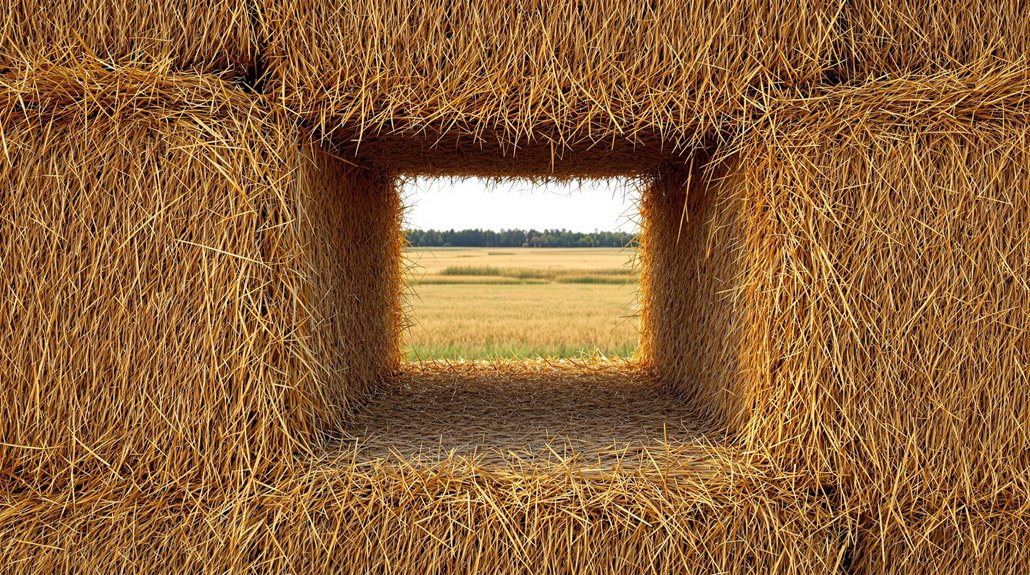Like a chameleon blending perfectly into its surroundings, I’ve discovered that building a hay bale blind is one of hunting’s best-kept secrets. I’ll share my time-tested techniques for constructing a blind that’s both practical and nearly invisible to wildlife, drawing from years of experience in the field. My method combines durability with natural camouflage, and once you understand the key principles of placement and construction, you’ll wonder why you haven’t tried this approach before.
Required Materials and Tools

Assembling a hay bale blind requires gathering several essential materials and tools before you begin the construction process.
I always start with four to six fresh hay bales as my foundation, making certain they’re tightly bound and weather-resistant. You’ll need heavy-duty stakes, camouflage netting, and waterproof tarps to protect against the elements.
For essential tools, I recommend bringing a hammer, heavy-duty scissors or knife, work gloves, and a measuring tape to ascertain proper placement.
I also pack zip ties, bungee cords, and agricultural twine to secure everything together.
Don’t forget safety equipment – you’ll want eye protection and a dust mask when handling hay bales.
In my experience, having a partner helps tremendously with the heavy lifting and positioning of materials.
Planning Your Blind Location
When selecting the perfect spot for your hay bale blind, you’ll need to carefully consider several key factors that will impact your hunting success.
I always start with a thorough terrain analysis, looking for natural funnels, water sources, and food plots that attract game. You’ll want to study wildlife patterns in your hunting area by looking for tracks, droppings, and well-worn trails.
I recommend positioning your blind where prevailing winds won’t carry your scent toward likely animal approaches. Make certain you’ve got clear shooting lanes in multiple directions, and guarantee there’s enough natural cover to break up your blind’s outline.
Don’t forget to check local regulations about blind placement and property boundaries. Consider the sun’s position throughout the day to avoid being backlit during prime hunting hours.
Safety Considerations and Permits
Before you start building your hay bale blind, let’s address the critical safety and legal requirements that need to be met.
I always check with local authorities about building permits and hunting regulations to guarantee I’m following all requirements for temporary structures on my property.
When it comes to construction, I make it a point to wear proper safety gear, including work gloves, steel-toed boots, and eye protection.
I’ll remind you that it’s vital to have a first aid kit nearby and never work alone when handling heavy bales.
If you’re building on public land, you’ll need special permissions, and I recommend posting visible markers to alert others of your presence during construction and hunting seasons.
Remember to check your local fire codes, as hay can be flammable in dry conditions.
Building the Base Foundation

To create a stable hunting blind that’ll last through the season, I start by selecting level ground and clearing away any vegetation, rocks, or debris in a 6×6 foot area.
Foundation stability begins with proper ground preparation, and I’ll guide you through the essential steps.
- Dig down 4 inches across the entire cleared area, using a level to guarantee the surface remains even throughout the process.
- Lay down landscaping fabric to prevent weed growth and maintain foundation stability over time.
- Add 2 inches of crushed gravel, tamping it down firmly to create a solid base.
- Place pressure-treated 4×4 posts at each corner, setting them 2 feet deep in quick-setting concrete for maximum structural support.
Frame Construction Steps
Building a sturdy frame requires careful attention to the basic structural elements that’ll support your hay bale walls. I’ll guide you through selecting appropriate frame dimensions and creating a reliable support structure that guarantees your safety while hunting.
| Material | Purpose | Safety Check |
|---|---|---|
| 2×4 Lumber | Wall frames | No splits/cracks |
| Corner Posts | Vertical support | Secure anchoring |
| Cross Beams | Roof support | Level placement |
| Metal Brackets | Joint strength | Tight fasteners |
| Base Plates | Ground contact | Moisture barrier |
When I construct my frames, I always start with pressure-treated lumber for the base plates. You’ll want to measure twice and cut once, confirming your frame dimensions match your planned blind size. I recommend installing diagonal bracing at each corner to prevent swaying, and don’t forget to check that every joint is properly secured.
Incorporating Real Hay Bales
Once your frame is secure, selecting and positioning the hay bales becomes your next critical task for creating an effective hunting blind.
I’ve found that proper bale selection and placement makes all the difference in creating a natural-looking, durable blind that’ll serve you well throughout the season.
- Choose fresh, tightly-packed real hay bales that haven’t been exposed to excessive moisture, as these will maintain their shape and resist deterioration.
- Place the heaviest, most uniform bales at the base of your blind for maximum stability.
- Stack bales in an overlapping pattern, similar to laying bricks, to prevent gaps that could expose your position.
- Secure each bale to your frame using heavy-duty twine or wire, ensuring they won’t shift during windy conditions.
Creating Entry Points and Shooting Windows

After securing your hay bales, proper placement of entry points and shooting windows becomes essential for creating a functional hunting blind that’ll serve you well.
I recommend cutting your entry point on the opposite side from where you expect game to approach, ensuring minimal visibility concerns when entering or exiting.
For shooting windows, I’ll help you create strategic openings at varying heights – one at sitting level and another at standing level.
When planning entry strategies, I make sure my door opening is at least 24 inches wide to accommodate gear and quiet movement.
I position shooting windows at angles that maximize your coverage area while maintaining concealment.
Remember to weatherproof these openings with small overhangs, and I suggest installing quiet-operating covers that you can adjust without spooking nearby wildlife.
Weatherproofing Your Blind
Since harsh weather can quickly damage an unprotected hay bale blind, I’ll show you my proven methods for creating a weatherproof hunting shelter that’ll last multiple seasons.
I’ve learned through experience that proper weatherproofing isn’t just about protection – it’s about extending your blind’s lifespan while keeping you dry and comfortable.
- Start by applying heavy-duty waterproof sealants to all exposed hay surfaces, paying special attention to the roof and entry points.
- Cover your blind with weather resistant coverings like marine-grade tarps, securing them tightly with UV-resistant rope or bungee cords.
- Install proper drainage channels around the base to prevent water pooling and hay rot.
- Create a slight roof pitch of at least 15 degrees, allowing rain and snow to naturally slide off instead of collecting.
Camouflage Techniques and Tips
While building a sturdy blind is important, proper camouflaging can make or break your hunting success in the field. I’ve found that matching your blind’s color patterns to the surrounding vegetation is essential, so I recommend using local grass, leaves, and small branches to create natural textures.
When I build my hay bale blinds, I always start by studying the seasonal changes in my hunting area. In spring, I’ll use fresh green vegetation, while fall calls for brown grasses and dead foliage.
I make sure to secure all camouflage materials tightly to prevent movement in the wind, and I’ll refresh them periodically as they fade. Remember to break up your blind’s outline by avoiding straight edges and incorporating irregular patterns that mimic nature’s random arrangements.
Maintenance and Storage

Because proper maintenance extends your hay bale blind’s lifespan, I’ve developed a routine checklist that keeps mine in great shape throughout hunting season.
Let me share my essential cleaning procedures and seasonal storage tips that’ll help protect your investment.
- After each hunt, remove any mud, leaves, or debris from the blind’s exterior and interior using a stiff brush, paying special attention to corners where moisture can collect.
- Check all support beams and reinforcement points monthly, tightening any loose screws or replacing damaged materials immediately.
- Before storing, thoroughly clean and dry the entire structure, then apply a waterproof spray to prevent mold growth.
- Store your blind in a covered location during off-season, elevated off the ground with a tarp underneath to prevent moisture damage.







